Many pool owners, gazing at their pool while thinking about their next move, notice stains…
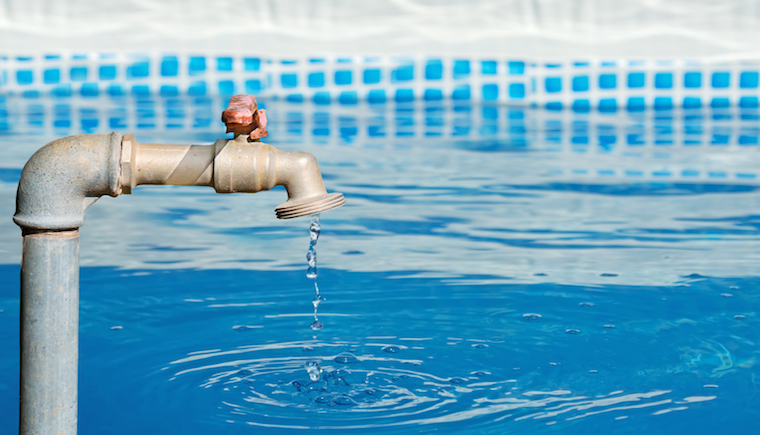
Where Does the Metal in My Pool Come From?
As a pool service contractor, I probably take two to three phone calls a week from customers with questions about metal stains in their pool or spa. One question I get frequently is, “How do I get rid of green stains (brown stains, red stains, you name it)?” Treatment for these stains can be a headache, and takes some effort to be successful. Depending on how tough the stain is, how long the stain has been there, and water balance conditions, multiple treatments can sometime be necessary to fully remove the stain.
Since stain removal can be a time-consuming and, sometimes, expensive process, I am amazed that customers never ask me these two questions: “Why is there metal in my pool?” and “How do I prevent metal stains?”
Why is there Metal in My Pool?

Most of us would not eat a whole chocolate cake and then wonder why we felt like going into hibernation soon afterwards. We understand that putting massive amounts of sugar into our bodies is going to cause problems. Rather than dealing with the effects of over-indulgence, most of us prefer to act proactively and prevent a sugar crash by stopping after one slice of cake.
Fortunately, pools and spas do not eat cake. They do, however, need water. And what does that water contain? You guessed it—metals. The water most of us fill our pools and spa with is laden with metals of various types and, left untreated, will have a negative effect on the finish.
How can you respond proactively to the metals in you water, so that you do not have to deal with the stains they will cause later? I’m glad you asked that!
How Do I Prevent Metal Stains?
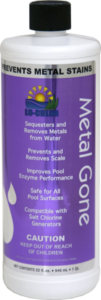
Unless you stop putting water in the pool or spa, the metal will always be there, looking for an opportunity to create stains. The solution recommended by pool professionals is the use of a sequestering agent, like Lo-Chlor Metal Gone, that binds to the metal particles in the water and prevents them from staining the finish of your pool or spa.
Although sequestering agents do their job well, adding water also adds metals, so you need to replenish the agent every time you add water. Adding a sequestering agent to your weekly maintenance routine, according to manufacturer’s directions, is a great way to prevent stains from occurring, eliminating the need to deal with them later on.
Now, if they only made something like this for cake…

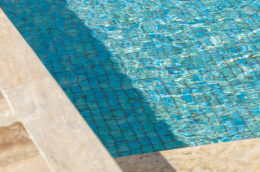
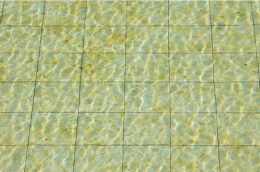
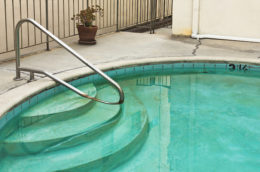
I recently had 2 layers of pool deck paint sanded off my concrete deck. A large majority of paint ended up in the pool. I have successfully removed about 99% of the sludge that it created on the bottom of the pool by vacuuming it out to waste. NOW my white vinyl steps have turned yellow which I know means metal. I have treated it twice and my water sample shows 0 copper and iron yet my steps are turning yellow again. There must be a metal in paint that my pool store does not test for. Can you help me?
Hello Tammy,
In addition to copper and iron, manganese is a common metal in water and it, too, causes stains. However, a yellow discoloration on pool surfaces is usually an indication of iron staining. Since your testing indicates zero iron in the water it is likely that the excess iron is already impregnated into your white vinyl steps. The stronger color intensity that you are seeing may be due to oxidation. Chlorine is a strong oxidizer and any iron present will exhibit more intense color as it experiences more oxidation.
Lo-Chlor’s Multi Stain Remover has a good chance at being quite effective against this stain but extra precautions to not over-treat need to be taken for vinyl surfaces. (Vinyl can contain all kinds of plasticizers and other chemicals that may react to over-treatment to cause permanent stains.) A helpful and low-risk approach would be to put some Multi Stain Remover powder into a white cotton athletic sock, tie it off and attach to the end of a pole (e.g. a pole brush pole or pool net pole). [Careful! Take all appropriate precautions to keep the product off of skin and away from eyes.] Once the pool water chlorine level is reduced and the pH is moderate-to-low, per the Multi Stain Remover use instructions, you can use the pole to place the filled sock on a section of the stain in an unobvious location for several seconds to see if the vinyl discolors and to see if the stain is being lifted.
As always, after treatment with Multi Stain Remover a good metal sequestrant like Lo-Chlor Metal Gone should be used to keep the metals from redepositing on pool surfaces. Do not re-enter the pool until the water conditions (pH, chlorine, etc.) have been returned to a safe and normal balance.
HELP! I am new to owning an inground pool and unfortunately the people that I bought my home from didn’t care for it as they should’ve. I have a few black stains in the deep end have tried EVERYTHING to get them out. I found out this is metal and am ordering the metal gone to prevent them but what about the spots there now that drove my ADHD and OCD insane?!! What can I do to get rid of them. Any help is GREATLY APPRECIATED:)
Hello Ashley,
To rid the pool of stubborn stains, use Lo-Chlor’s Multi-Stain Remover, which works on all kinds of pool surface stains. https://lo-chlor.com/product/127-lo-chlor-multi-stain-remover/